Management Accounting: Costing Techniques and Financial Reporting
VerifiedAdded on 2024/06/21
|24
|5560
|496
Report
AI Summary
This report provides a detailed analysis of management accounting principles, focusing on cost analysis techniques and financial reporting methods. It explains the essential requirements of different management accounting systems and explores the origin, role, and principles of management accounting, highlighting the distinction between management and financial accounting. The report also calculates costs using marginal and absorption costing techniques to prepare income statements, analyzing microeconomic techniques such as cost-volume profit. The report uses Prime Furniture as a case study. Desklib offers a platform to access this and many other solved assignments for students.
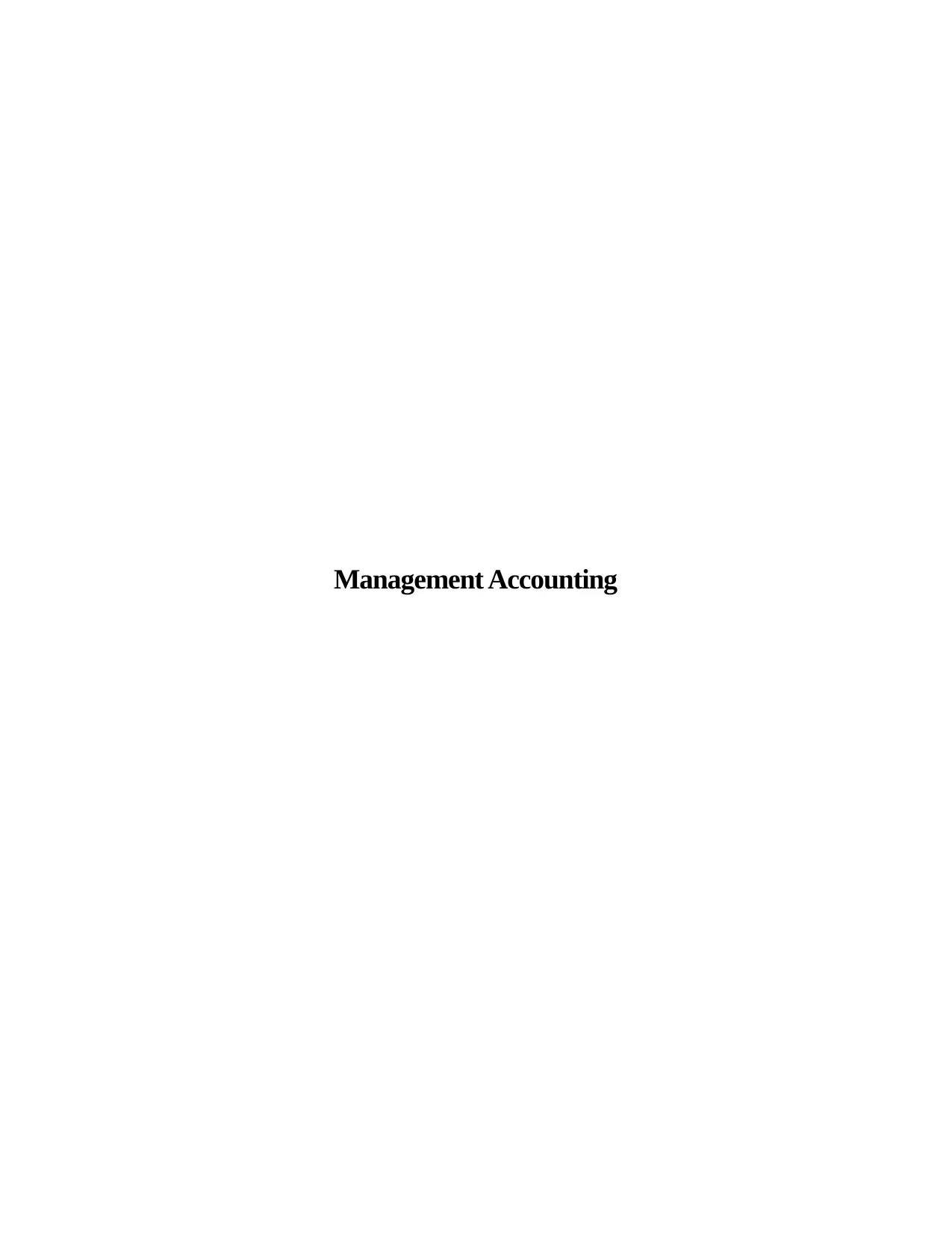
Management Accounting
Paraphrase This Document
Need a fresh take? Get an instant paraphrase of this document with our AI Paraphraser
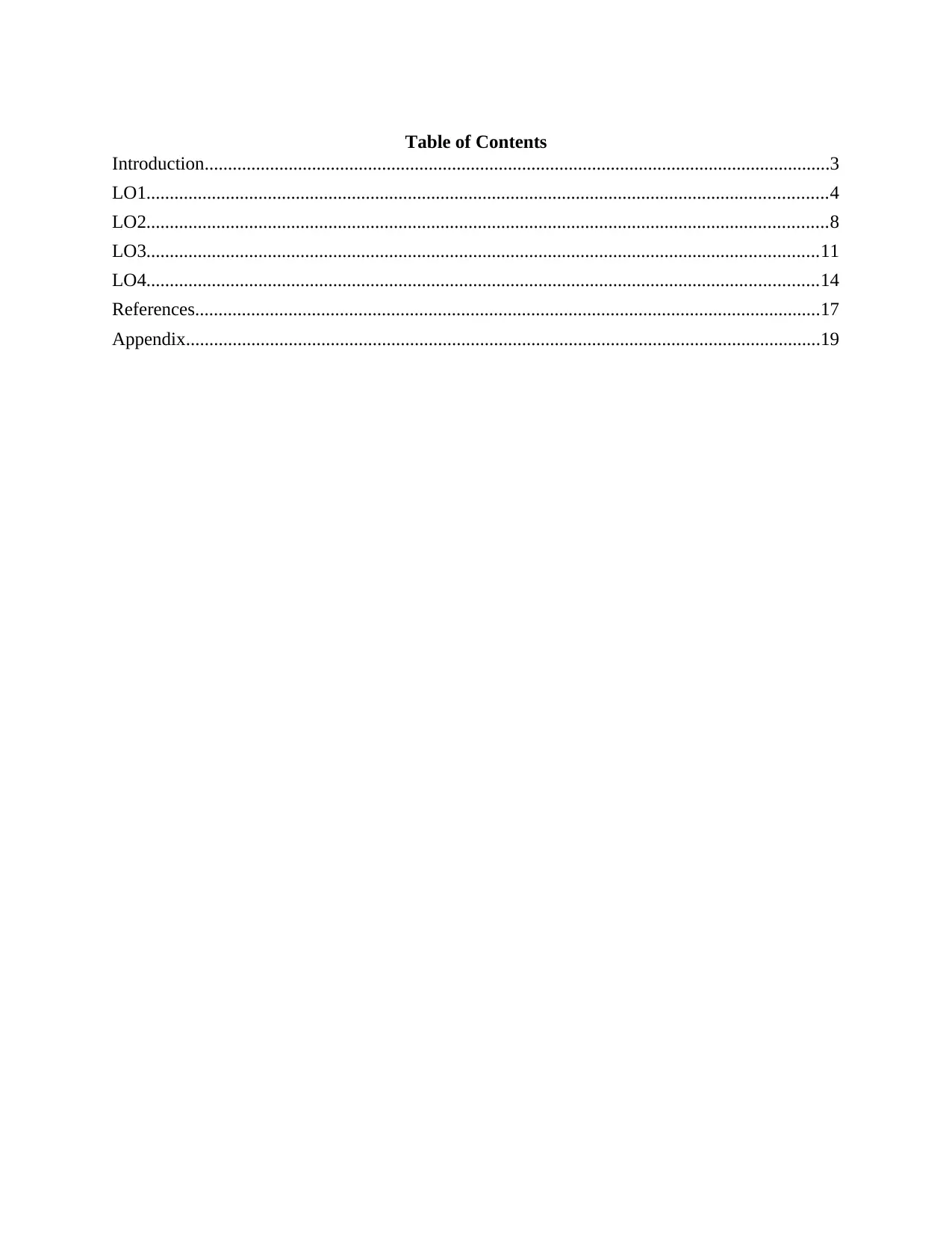
Table of Contents
Introduction......................................................................................................................................3
LO1..................................................................................................................................................4
LO2..................................................................................................................................................8
LO3................................................................................................................................................11
LO4................................................................................................................................................14
References......................................................................................................................................17
Appendix........................................................................................................................................19
Introduction......................................................................................................................................3
LO1..................................................................................................................................................4
LO2..................................................................................................................................................8
LO3................................................................................................................................................11
LO4................................................................................................................................................14
References......................................................................................................................................17
Appendix........................................................................................................................................19
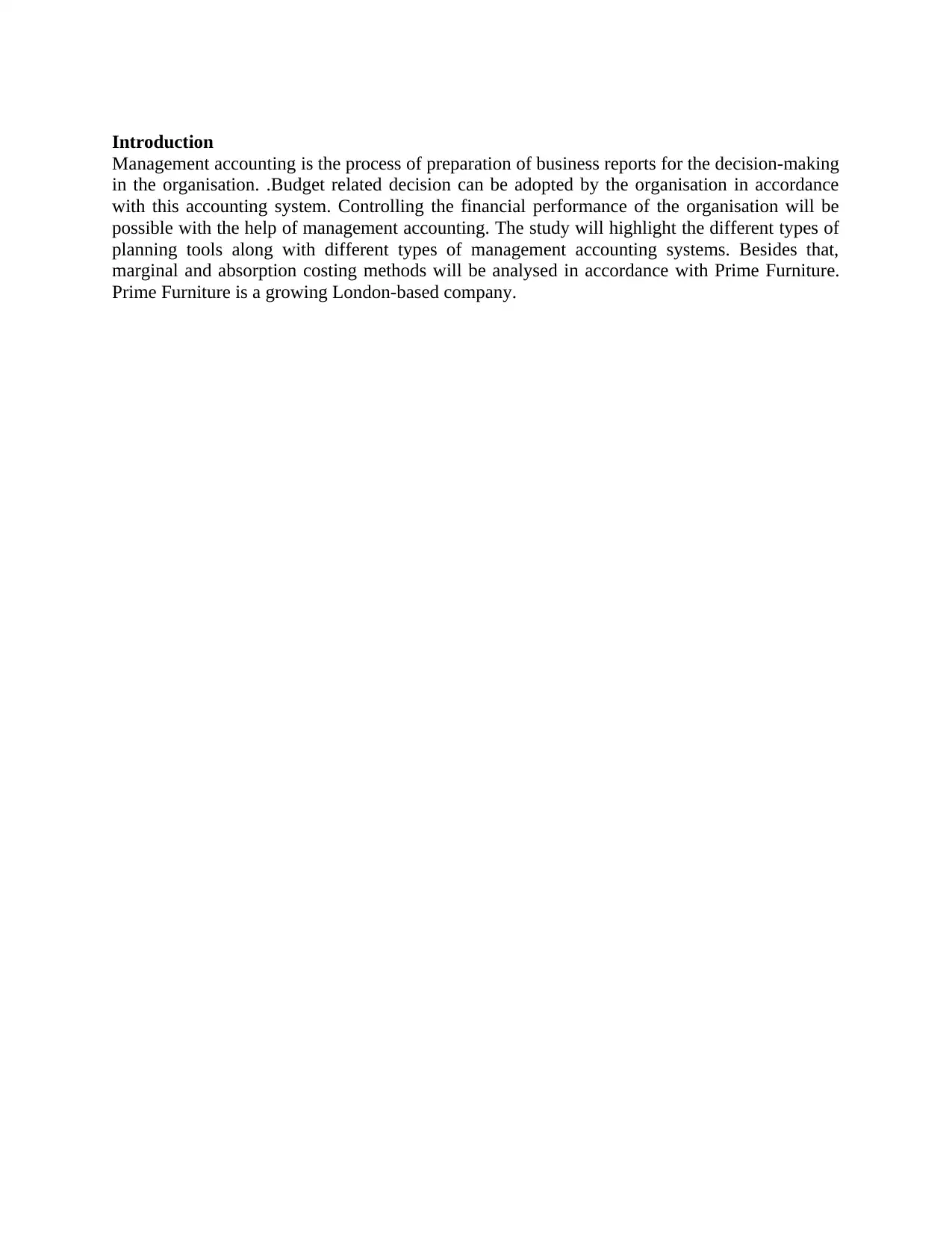
Introduction
Management accounting is the process of preparation of business reports for the decision-making
in the organisation. .Budget related decision can be adopted by the organisation in accordance
with this accounting system. Controlling the financial performance of the organisation will be
possible with the help of management accounting. The study will highlight the different types of
planning tools along with different types of management accounting systems. Besides that,
marginal and absorption costing methods will be analysed in accordance with Prime Furniture.
Prime Furniture is a growing London-based company.
Management accounting is the process of preparation of business reports for the decision-making
in the organisation. .Budget related decision can be adopted by the organisation in accordance
with this accounting system. Controlling the financial performance of the organisation will be
possible with the help of management accounting. The study will highlight the different types of
planning tools along with different types of management accounting systems. Besides that,
marginal and absorption costing methods will be analysed in accordance with Prime Furniture.
Prime Furniture is a growing London-based company.
⊘ This is a preview!⊘
Do you want full access?
Subscribe today to unlock all pages.

Trusted by 1+ million students worldwide
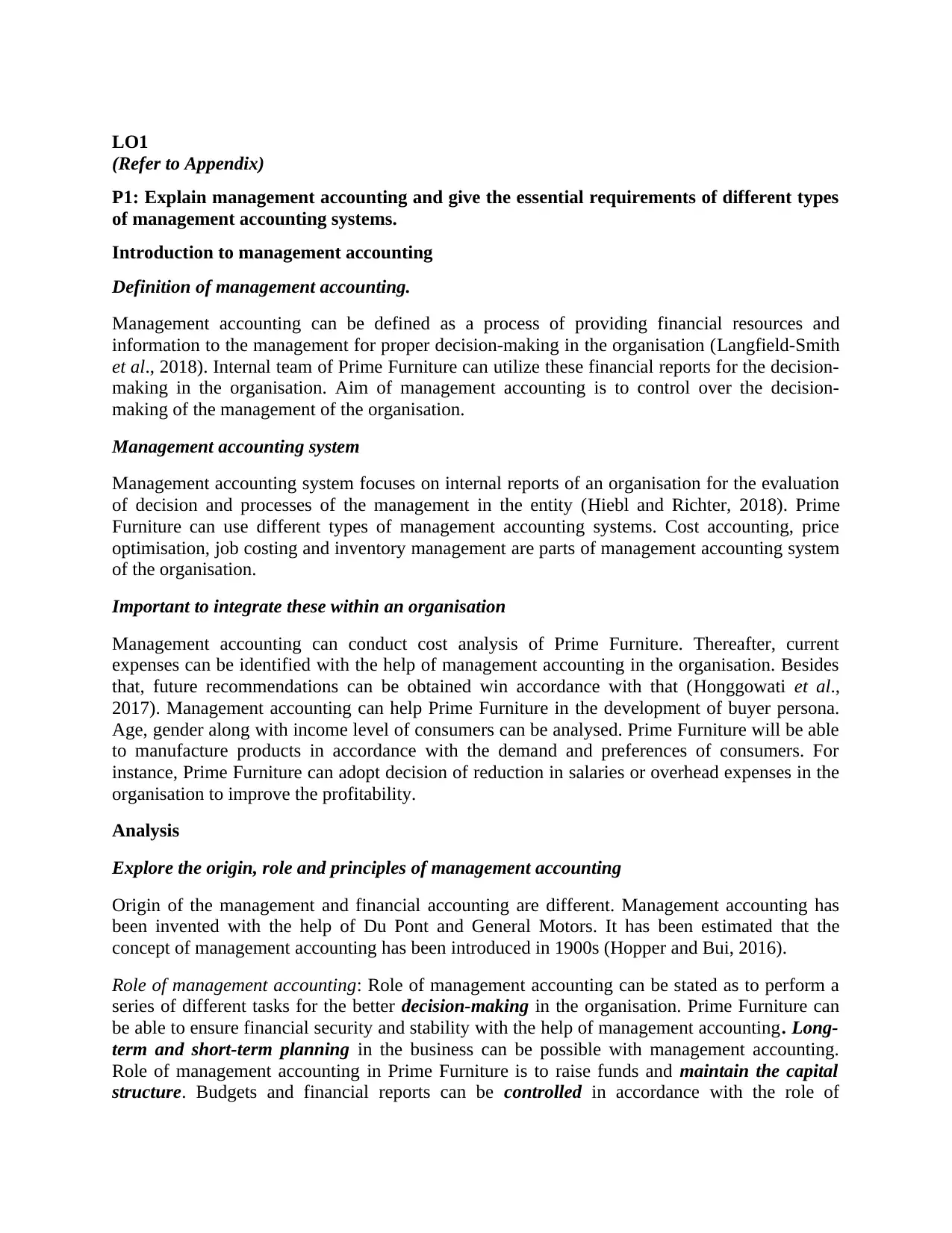
LO1
(Refer to Appendix)
P1: Explain management accounting and give the essential requirements of different types
of management accounting systems.
Introduction to management accounting
Definition of management accounting.
Management accounting can be defined as a process of providing financial resources and
information to the management for proper decision-making in the organisation (Langfield-Smith
et al., 2018). Internal team of Prime Furniture can utilize these financial reports for the decision-
making in the organisation. Aim of management accounting is to control over the decision-
making of the management of the organisation.
Management accounting system
Management accounting system focuses on internal reports of an organisation for the evaluation
of decision and processes of the management in the entity (Hiebl and Richter, 2018). Prime
Furniture can use different types of management accounting systems. Cost accounting, price
optimisation, job costing and inventory management are parts of management accounting system
of the organisation.
Important to integrate these within an organisation
Management accounting can conduct cost analysis of Prime Furniture. Thereafter, current
expenses can be identified with the help of management accounting in the organisation. Besides
that, future recommendations can be obtained win accordance with that (Honggowati et al.,
2017). Management accounting can help Prime Furniture in the development of buyer persona.
Age, gender along with income level of consumers can be analysed. Prime Furniture will be able
to manufacture products in accordance with the demand and preferences of consumers. For
instance, Prime Furniture can adopt decision of reduction in salaries or overhead expenses in the
organisation to improve the profitability.
Analysis
Explore the origin, role and principles of management accounting
Origin of the management and financial accounting are different. Management accounting has
been invented with the help of Du Pont and General Motors. It has been estimated that the
concept of management accounting has been introduced in 1900s (Hopper and Bui, 2016).
Role of management accounting: Role of management accounting can be stated as to perform a
series of different tasks for the better decision-making in the organisation. Prime Furniture can
be able to ensure financial security and stability with the help of management accounting. Long-
term and short-term planning in the business can be possible with management accounting.
Role of management accounting in Prime Furniture is to raise funds and maintain the capital
structure. Budgets and financial reports can be controlled in accordance with the role of
(Refer to Appendix)
P1: Explain management accounting and give the essential requirements of different types
of management accounting systems.
Introduction to management accounting
Definition of management accounting.
Management accounting can be defined as a process of providing financial resources and
information to the management for proper decision-making in the organisation (Langfield-Smith
et al., 2018). Internal team of Prime Furniture can utilize these financial reports for the decision-
making in the organisation. Aim of management accounting is to control over the decision-
making of the management of the organisation.
Management accounting system
Management accounting system focuses on internal reports of an organisation for the evaluation
of decision and processes of the management in the entity (Hiebl and Richter, 2018). Prime
Furniture can use different types of management accounting systems. Cost accounting, price
optimisation, job costing and inventory management are parts of management accounting system
of the organisation.
Important to integrate these within an organisation
Management accounting can conduct cost analysis of Prime Furniture. Thereafter, current
expenses can be identified with the help of management accounting in the organisation. Besides
that, future recommendations can be obtained win accordance with that (Honggowati et al.,
2017). Management accounting can help Prime Furniture in the development of buyer persona.
Age, gender along with income level of consumers can be analysed. Prime Furniture will be able
to manufacture products in accordance with the demand and preferences of consumers. For
instance, Prime Furniture can adopt decision of reduction in salaries or overhead expenses in the
organisation to improve the profitability.
Analysis
Explore the origin, role and principles of management accounting
Origin of the management and financial accounting are different. Management accounting has
been invented with the help of Du Pont and General Motors. It has been estimated that the
concept of management accounting has been introduced in 1900s (Hopper and Bui, 2016).
Role of management accounting: Role of management accounting can be stated as to perform a
series of different tasks for the better decision-making in the organisation. Prime Furniture can
be able to ensure financial security and stability with the help of management accounting. Long-
term and short-term planning in the business can be possible with management accounting.
Role of management accounting in Prime Furniture is to raise funds and maintain the capital
structure. Budgets and financial reports can be controlled in accordance with the role of
Paraphrase This Document
Need a fresh take? Get an instant paraphrase of this document with our AI Paraphraser
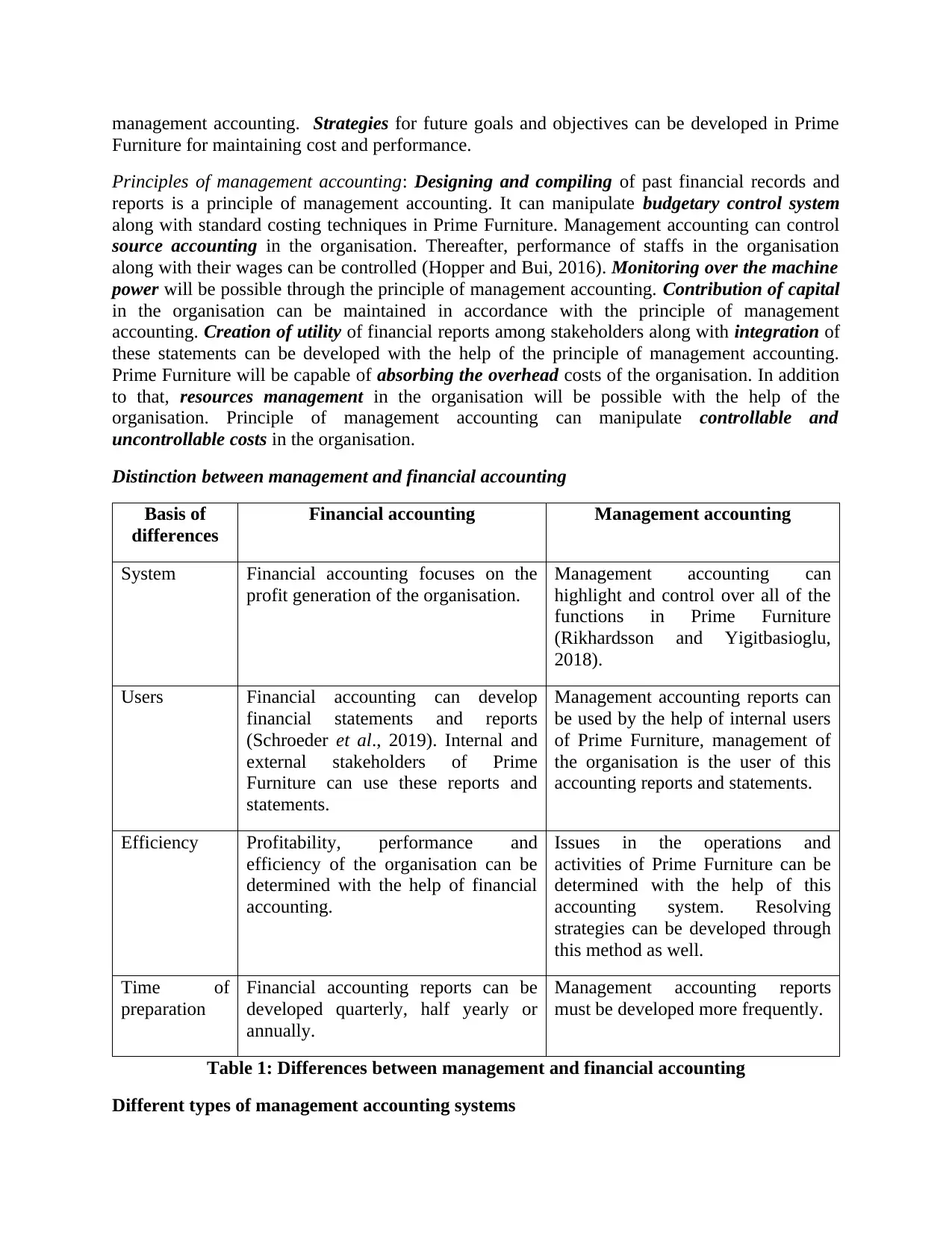
management accounting. Strategies for future goals and objectives can be developed in Prime
Furniture for maintaining cost and performance.
Principles of management accounting: Designing and compiling of past financial records and
reports is a principle of management accounting. It can manipulate budgetary control system
along with standard costing techniques in Prime Furniture. Management accounting can control
source accounting in the organisation. Thereafter, performance of staffs in the organisation
along with their wages can be controlled (Hopper and Bui, 2016). Monitoring over the machine
power will be possible through the principle of management accounting. Contribution of capital
in the organisation can be maintained in accordance with the principle of management
accounting. Creation of utility of financial reports among stakeholders along with integration of
these statements can be developed with the help of the principle of management accounting.
Prime Furniture will be capable of absorbing the overhead costs of the organisation. In addition
to that, resources management in the organisation will be possible with the help of the
organisation. Principle of management accounting can manipulate controllable and
uncontrollable costs in the organisation.
Distinction between management and financial accounting
Basis of
differences
Financial accounting Management accounting
System Financial accounting focuses on the
profit generation of the organisation.
Management accounting can
highlight and control over all of the
functions in Prime Furniture
(Rikhardsson and Yigitbasioglu,
2018).
Users Financial accounting can develop
financial statements and reports
(Schroeder et al., 2019). Internal and
external stakeholders of Prime
Furniture can use these reports and
statements.
Management accounting reports can
be used by the help of internal users
of Prime Furniture, management of
the organisation is the user of this
accounting reports and statements.
Efficiency Profitability, performance and
efficiency of the organisation can be
determined with the help of financial
accounting.
Issues in the operations and
activities of Prime Furniture can be
determined with the help of this
accounting system. Resolving
strategies can be developed through
this method as well.
Time of
preparation
Financial accounting reports can be
developed quarterly, half yearly or
annually.
Management accounting reports
must be developed more frequently.
Table 1: Differences between management and financial accounting
Different types of management accounting systems
Furniture for maintaining cost and performance.
Principles of management accounting: Designing and compiling of past financial records and
reports is a principle of management accounting. It can manipulate budgetary control system
along with standard costing techniques in Prime Furniture. Management accounting can control
source accounting in the organisation. Thereafter, performance of staffs in the organisation
along with their wages can be controlled (Hopper and Bui, 2016). Monitoring over the machine
power will be possible through the principle of management accounting. Contribution of capital
in the organisation can be maintained in accordance with the principle of management
accounting. Creation of utility of financial reports among stakeholders along with integration of
these statements can be developed with the help of the principle of management accounting.
Prime Furniture will be capable of absorbing the overhead costs of the organisation. In addition
to that, resources management in the organisation will be possible with the help of the
organisation. Principle of management accounting can manipulate controllable and
uncontrollable costs in the organisation.
Distinction between management and financial accounting
Basis of
differences
Financial accounting Management accounting
System Financial accounting focuses on the
profit generation of the organisation.
Management accounting can
highlight and control over all of the
functions in Prime Furniture
(Rikhardsson and Yigitbasioglu,
2018).
Users Financial accounting can develop
financial statements and reports
(Schroeder et al., 2019). Internal and
external stakeholders of Prime
Furniture can use these reports and
statements.
Management accounting reports can
be used by the help of internal users
of Prime Furniture, management of
the organisation is the user of this
accounting reports and statements.
Efficiency Profitability, performance and
efficiency of the organisation can be
determined with the help of financial
accounting.
Issues in the operations and
activities of Prime Furniture can be
determined with the help of this
accounting system. Resolving
strategies can be developed through
this method as well.
Time of
preparation
Financial accounting reports can be
developed quarterly, half yearly or
annually.
Management accounting reports
must be developed more frequently.
Table 1: Differences between management and financial accounting
Different types of management accounting systems
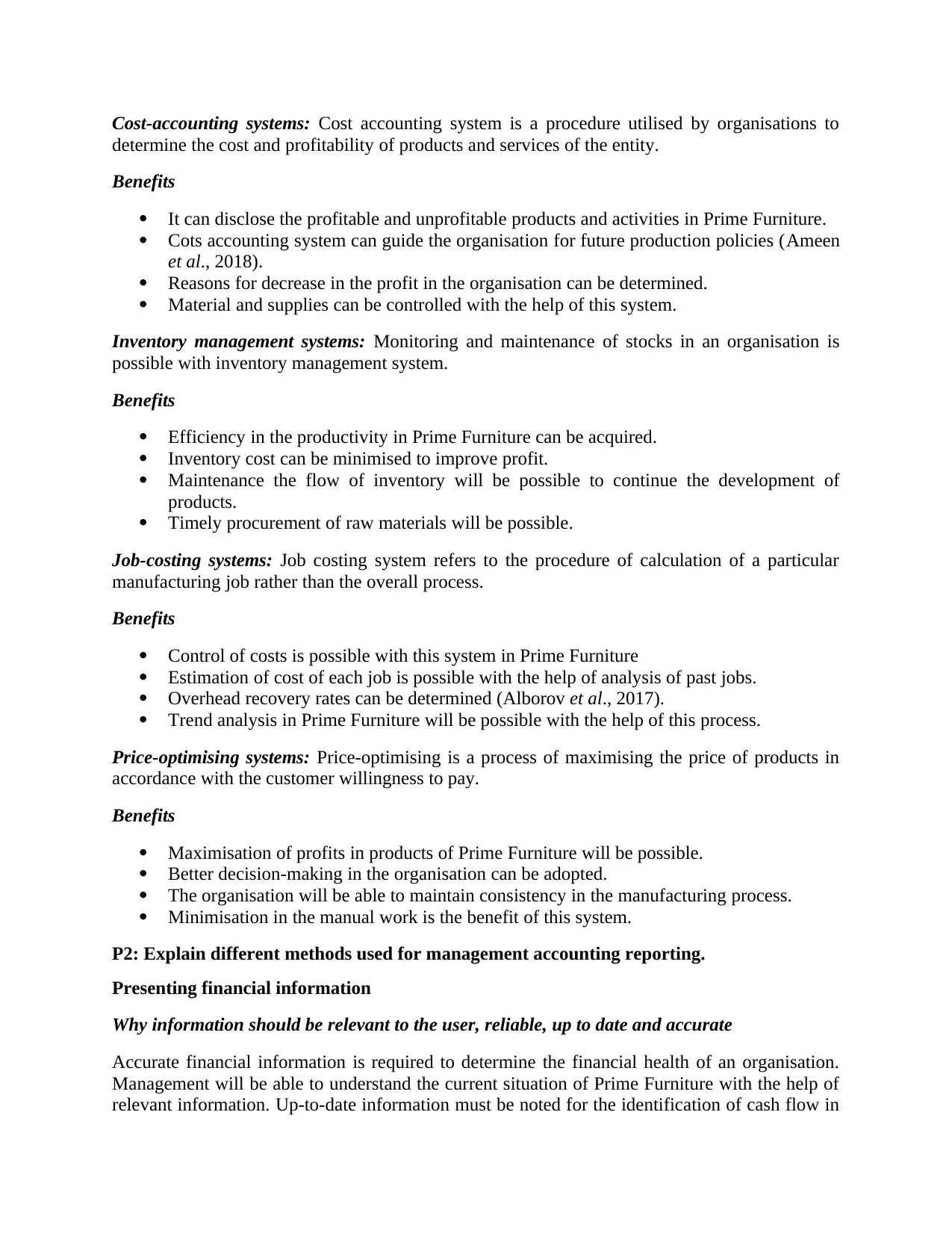
Cost-accounting systems: Cost accounting system is a procedure utilised by organisations to
determine the cost and profitability of products and services of the entity.
Benefits
It can disclose the profitable and unprofitable products and activities in Prime Furniture.
Cots accounting system can guide the organisation for future production policies (Ameen
et al., 2018).
Reasons for decrease in the profit in the organisation can be determined.
Material and supplies can be controlled with the help of this system.
Inventory management systems: Monitoring and maintenance of stocks in an organisation is
possible with inventory management system.
Benefits
Efficiency in the productivity in Prime Furniture can be acquired.
Inventory cost can be minimised to improve profit.
Maintenance the flow of inventory will be possible to continue the development of
products.
Timely procurement of raw materials will be possible.
Job-costing systems: Job costing system refers to the procedure of calculation of a particular
manufacturing job rather than the overall process.
Benefits
Control of costs is possible with this system in Prime Furniture
Estimation of cost of each job is possible with the help of analysis of past jobs.
Overhead recovery rates can be determined (Alborov et al., 2017).
Trend analysis in Prime Furniture will be possible with the help of this process.
Price-optimising systems: Price-optimising is a process of maximising the price of products in
accordance with the customer willingness to pay.
Benefits
Maximisation of profits in products of Prime Furniture will be possible.
Better decision-making in the organisation can be adopted.
The organisation will be able to maintain consistency in the manufacturing process.
Minimisation in the manual work is the benefit of this system.
P2: Explain different methods used for management accounting reporting.
Presenting financial information
Why information should be relevant to the user, reliable, up to date and accurate
Accurate financial information is required to determine the financial health of an organisation.
Management will be able to understand the current situation of Prime Furniture with the help of
relevant information. Up-to-date information must be noted for the identification of cash flow in
determine the cost and profitability of products and services of the entity.
Benefits
It can disclose the profitable and unprofitable products and activities in Prime Furniture.
Cots accounting system can guide the organisation for future production policies (Ameen
et al., 2018).
Reasons for decrease in the profit in the organisation can be determined.
Material and supplies can be controlled with the help of this system.
Inventory management systems: Monitoring and maintenance of stocks in an organisation is
possible with inventory management system.
Benefits
Efficiency in the productivity in Prime Furniture can be acquired.
Inventory cost can be minimised to improve profit.
Maintenance the flow of inventory will be possible to continue the development of
products.
Timely procurement of raw materials will be possible.
Job-costing systems: Job costing system refers to the procedure of calculation of a particular
manufacturing job rather than the overall process.
Benefits
Control of costs is possible with this system in Prime Furniture
Estimation of cost of each job is possible with the help of analysis of past jobs.
Overhead recovery rates can be determined (Alborov et al., 2017).
Trend analysis in Prime Furniture will be possible with the help of this process.
Price-optimising systems: Price-optimising is a process of maximising the price of products in
accordance with the customer willingness to pay.
Benefits
Maximisation of profits in products of Prime Furniture will be possible.
Better decision-making in the organisation can be adopted.
The organisation will be able to maintain consistency in the manufacturing process.
Minimisation in the manual work is the benefit of this system.
P2: Explain different methods used for management accounting reporting.
Presenting financial information
Why information should be relevant to the user, reliable, up to date and accurate
Accurate financial information is required to determine the financial health of an organisation.
Management will be able to understand the current situation of Prime Furniture with the help of
relevant information. Up-to-date information must be noted for the identification of cash flow in
⊘ This is a preview!⊘
Do you want full access?
Subscribe today to unlock all pages.

Trusted by 1+ million students worldwide
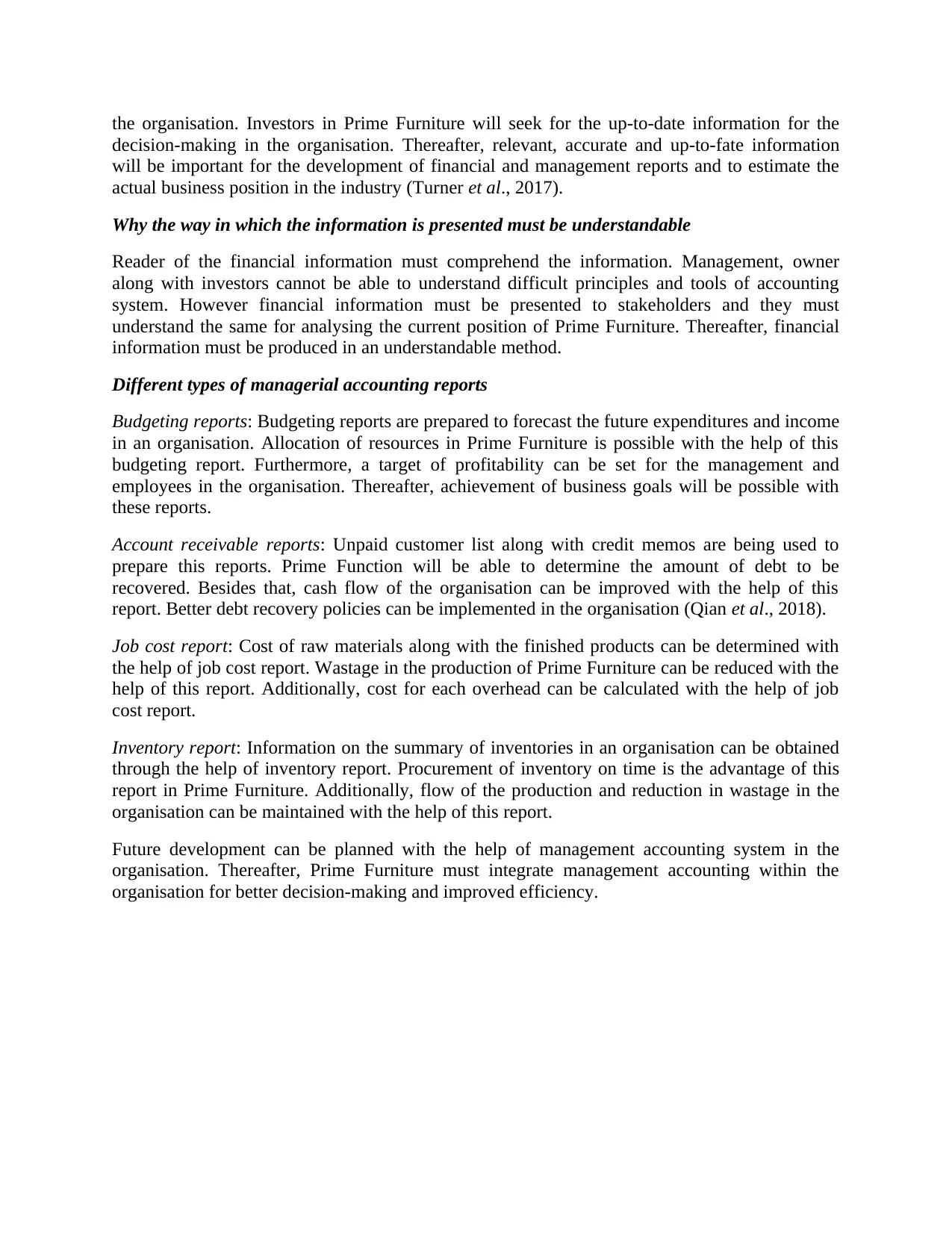
the organisation. Investors in Prime Furniture will seek for the up-to-date information for the
decision-making in the organisation. Thereafter, relevant, accurate and up-to-fate information
will be important for the development of financial and management reports and to estimate the
actual business position in the industry (Turner et al., 2017).
Why the way in which the information is presented must be understandable
Reader of the financial information must comprehend the information. Management, owner
along with investors cannot be able to understand difficult principles and tools of accounting
system. However financial information must be presented to stakeholders and they must
understand the same for analysing the current position of Prime Furniture. Thereafter, financial
information must be produced in an understandable method.
Different types of managerial accounting reports
Budgeting reports: Budgeting reports are prepared to forecast the future expenditures and income
in an organisation. Allocation of resources in Prime Furniture is possible with the help of this
budgeting report. Furthermore, a target of profitability can be set for the management and
employees in the organisation. Thereafter, achievement of business goals will be possible with
these reports.
Account receivable reports: Unpaid customer list along with credit memos are being used to
prepare this reports. Prime Function will be able to determine the amount of debt to be
recovered. Besides that, cash flow of the organisation can be improved with the help of this
report. Better debt recovery policies can be implemented in the organisation (Qian et al., 2018).
Job cost report: Cost of raw materials along with the finished products can be determined with
the help of job cost report. Wastage in the production of Prime Furniture can be reduced with the
help of this report. Additionally, cost for each overhead can be calculated with the help of job
cost report.
Inventory report: Information on the summary of inventories in an organisation can be obtained
through the help of inventory report. Procurement of inventory on time is the advantage of this
report in Prime Furniture. Additionally, flow of the production and reduction in wastage in the
organisation can be maintained with the help of this report.
Future development can be planned with the help of management accounting system in the
organisation. Thereafter, Prime Furniture must integrate management accounting within the
organisation for better decision-making and improved efficiency.
decision-making in the organisation. Thereafter, relevant, accurate and up-to-fate information
will be important for the development of financial and management reports and to estimate the
actual business position in the industry (Turner et al., 2017).
Why the way in which the information is presented must be understandable
Reader of the financial information must comprehend the information. Management, owner
along with investors cannot be able to understand difficult principles and tools of accounting
system. However financial information must be presented to stakeholders and they must
understand the same for analysing the current position of Prime Furniture. Thereafter, financial
information must be produced in an understandable method.
Different types of managerial accounting reports
Budgeting reports: Budgeting reports are prepared to forecast the future expenditures and income
in an organisation. Allocation of resources in Prime Furniture is possible with the help of this
budgeting report. Furthermore, a target of profitability can be set for the management and
employees in the organisation. Thereafter, achievement of business goals will be possible with
these reports.
Account receivable reports: Unpaid customer list along with credit memos are being used to
prepare this reports. Prime Function will be able to determine the amount of debt to be
recovered. Besides that, cash flow of the organisation can be improved with the help of this
report. Better debt recovery policies can be implemented in the organisation (Qian et al., 2018).
Job cost report: Cost of raw materials along with the finished products can be determined with
the help of job cost report. Wastage in the production of Prime Furniture can be reduced with the
help of this report. Additionally, cost for each overhead can be calculated with the help of job
cost report.
Inventory report: Information on the summary of inventories in an organisation can be obtained
through the help of inventory report. Procurement of inventory on time is the advantage of this
report in Prime Furniture. Additionally, flow of the production and reduction in wastage in the
organisation can be maintained with the help of this report.
Future development can be planned with the help of management accounting system in the
organisation. Thereafter, Prime Furniture must integrate management accounting within the
organisation for better decision-making and improved efficiency.
Paraphrase This Document
Need a fresh take? Get an instant paraphrase of this document with our AI Paraphraser
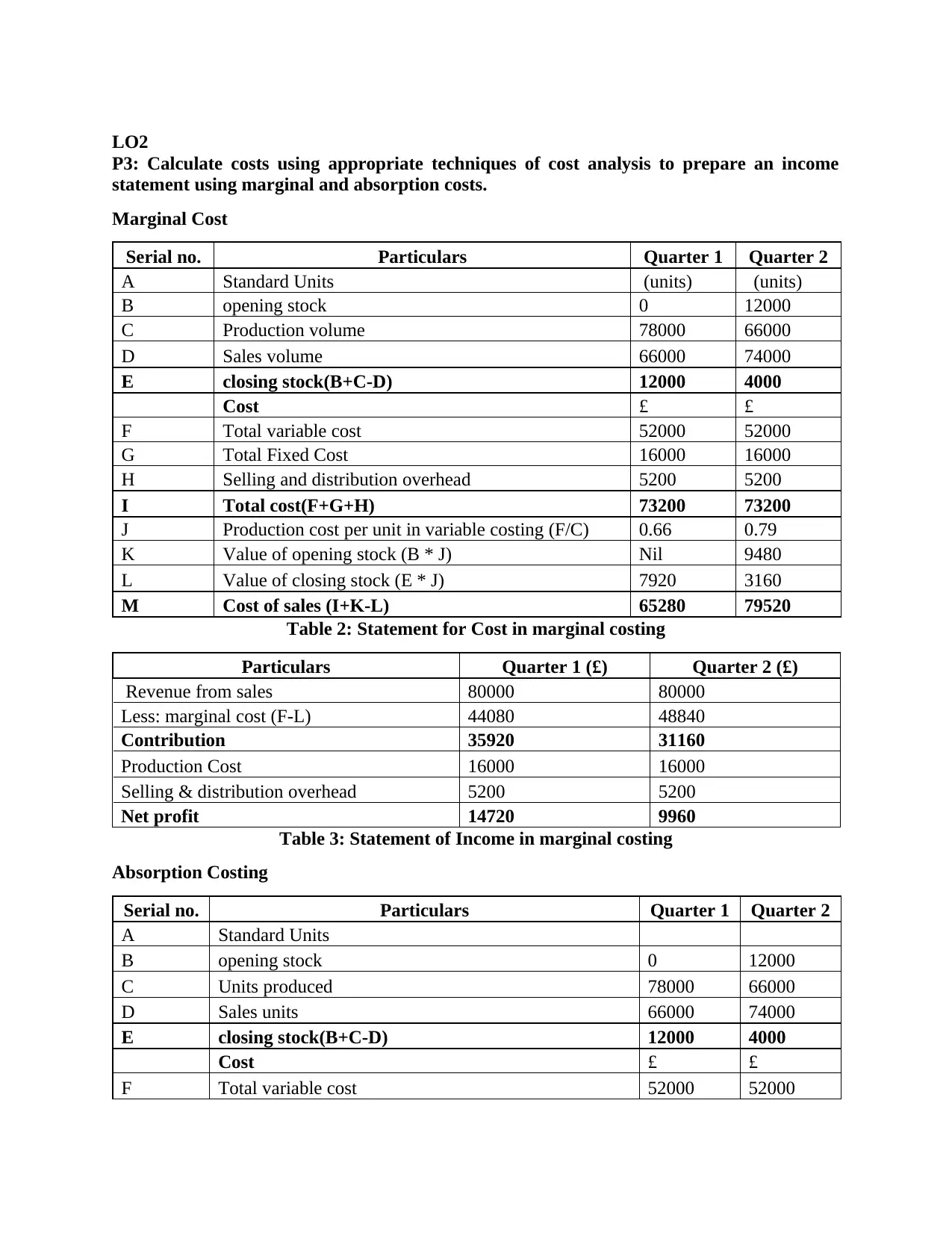
LO2
P3: Calculate costs using appropriate techniques of cost analysis to prepare an income
statement using marginal and absorption costs.
Marginal Cost
Serial no. Particulars Quarter 1 Quarter 2
A Standard Units (units) (units)
B opening stock 0 12000
C Production volume 78000 66000
D Sales volume 66000 74000
E closing stock(B+C-D) 12000 4000
Cost £ £
F Total variable cost 52000 52000
G Total Fixed Cost 16000 16000
H Selling and distribution overhead 5200 5200
I Total cost(F+G+H) 73200 73200
J Production cost per unit in variable costing (F/C) 0.66 0.79
K Value of opening stock (B * J) Nil 9480
L Value of closing stock (E * J) 7920 3160
M Cost of sales (I+K-L) 65280 79520
Table 2: Statement for Cost in marginal costing
Particulars Quarter 1 (£) Quarter 2 (£)
Revenue from sales 80000 80000
Less: marginal cost (F-L) 44080 48840
Contribution 35920 31160
Production Cost 16000 16000
Selling & distribution overhead 5200 5200
Net profit 14720 9960
Table 3: Statement of Income in marginal costing
Absorption Costing
Serial no. Particulars Quarter 1 Quarter 2
A Standard Units
B opening stock 0 12000
C Units produced 78000 66000
D Sales units 66000 74000
E closing stock(B+C-D) 12000 4000
Cost £ £
F Total variable cost 52000 52000
P3: Calculate costs using appropriate techniques of cost analysis to prepare an income
statement using marginal and absorption costs.
Marginal Cost
Serial no. Particulars Quarter 1 Quarter 2
A Standard Units (units) (units)
B opening stock 0 12000
C Production volume 78000 66000
D Sales volume 66000 74000
E closing stock(B+C-D) 12000 4000
Cost £ £
F Total variable cost 52000 52000
G Total Fixed Cost 16000 16000
H Selling and distribution overhead 5200 5200
I Total cost(F+G+H) 73200 73200
J Production cost per unit in variable costing (F/C) 0.66 0.79
K Value of opening stock (B * J) Nil 9480
L Value of closing stock (E * J) 7920 3160
M Cost of sales (I+K-L) 65280 79520
Table 2: Statement for Cost in marginal costing
Particulars Quarter 1 (£) Quarter 2 (£)
Revenue from sales 80000 80000
Less: marginal cost (F-L) 44080 48840
Contribution 35920 31160
Production Cost 16000 16000
Selling & distribution overhead 5200 5200
Net profit 14720 9960
Table 3: Statement of Income in marginal costing
Absorption Costing
Serial no. Particulars Quarter 1 Quarter 2
A Standard Units
B opening stock 0 12000
C Units produced 78000 66000
D Sales units 66000 74000
E closing stock(B+C-D) 12000 4000
Cost £ £
F Total variable cost 52000 52000
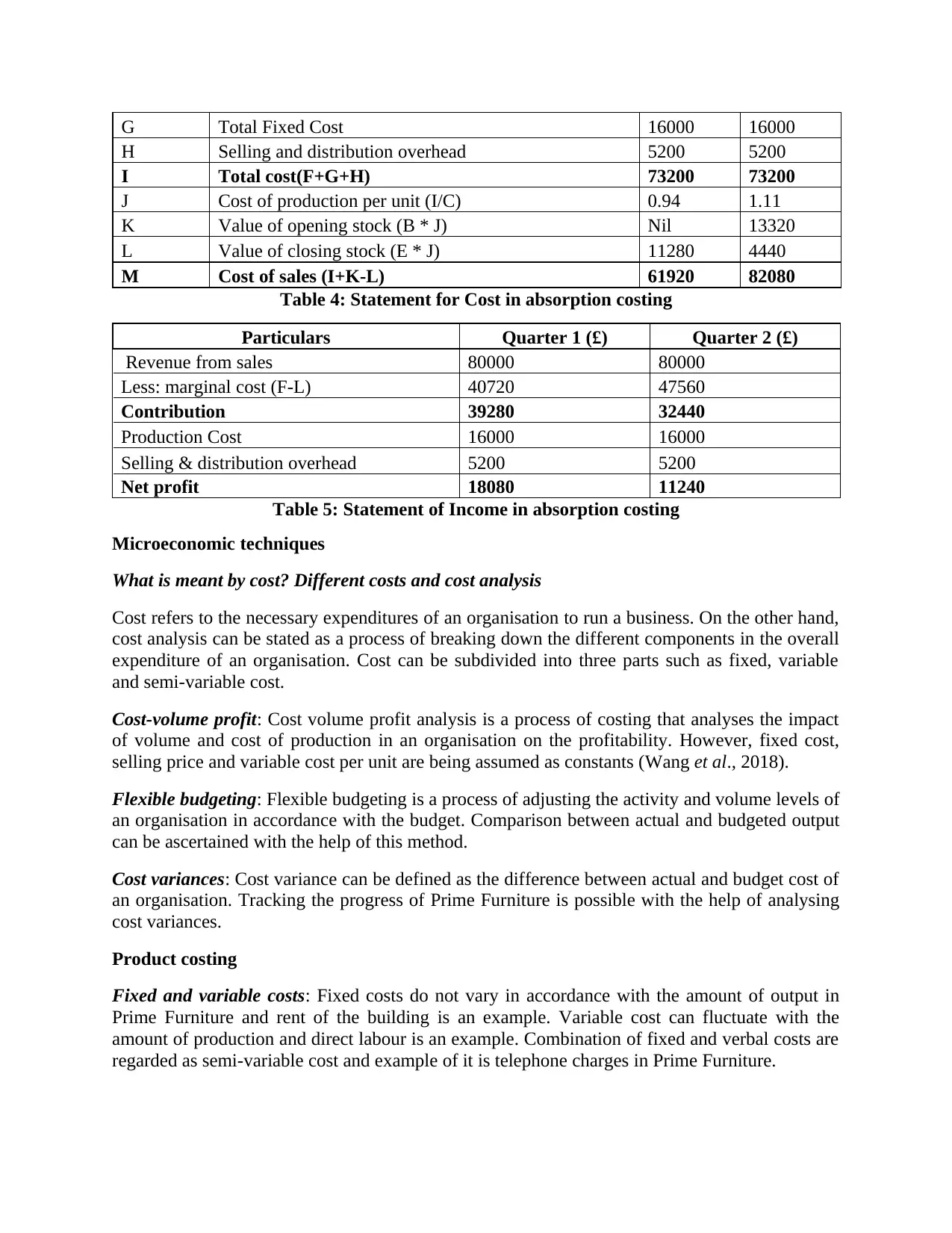
G Total Fixed Cost 16000 16000
H Selling and distribution overhead 5200 5200
I Total cost(F+G+H) 73200 73200
J Cost of production per unit (I/C) 0.94 1.11
K Value of opening stock (B * J) Nil 13320
L Value of closing stock (E * J) 11280 4440
M Cost of sales (I+K-L) 61920 82080
Table 4: Statement for Cost in absorption costing
Particulars Quarter 1 (£) Quarter 2 (£)
Revenue from sales 80000 80000
Less: marginal cost (F-L) 40720 47560
Contribution 39280 32440
Production Cost 16000 16000
Selling & distribution overhead 5200 5200
Net profit 18080 11240
Table 5: Statement of Income in absorption costing
Microeconomic techniques
What is meant by cost? Different costs and cost analysis
Cost refers to the necessary expenditures of an organisation to run a business. On the other hand,
cost analysis can be stated as a process of breaking down the different components in the overall
expenditure of an organisation. Cost can be subdivided into three parts such as fixed, variable
and semi-variable cost.
Cost-volume profit: Cost volume profit analysis is a process of costing that analyses the impact
of volume and cost of production in an organisation on the profitability. However, fixed cost,
selling price and variable cost per unit are being assumed as constants (Wang et al., 2018).
Flexible budgeting: Flexible budgeting is a process of adjusting the activity and volume levels of
an organisation in accordance with the budget. Comparison between actual and budgeted output
can be ascertained with the help of this method.
Cost variances: Cost variance can be defined as the difference between actual and budget cost of
an organisation. Tracking the progress of Prime Furniture is possible with the help of analysing
cost variances.
Product costing
Fixed and variable costs: Fixed costs do not vary in accordance with the amount of output in
Prime Furniture and rent of the building is an example. Variable cost can fluctuate with the
amount of production and direct labour is an example. Combination of fixed and verbal costs are
regarded as semi-variable cost and example of it is telephone charges in Prime Furniture.
H Selling and distribution overhead 5200 5200
I Total cost(F+G+H) 73200 73200
J Cost of production per unit (I/C) 0.94 1.11
K Value of opening stock (B * J) Nil 13320
L Value of closing stock (E * J) 11280 4440
M Cost of sales (I+K-L) 61920 82080
Table 4: Statement for Cost in absorption costing
Particulars Quarter 1 (£) Quarter 2 (£)
Revenue from sales 80000 80000
Less: marginal cost (F-L) 40720 47560
Contribution 39280 32440
Production Cost 16000 16000
Selling & distribution overhead 5200 5200
Net profit 18080 11240
Table 5: Statement of Income in absorption costing
Microeconomic techniques
What is meant by cost? Different costs and cost analysis
Cost refers to the necessary expenditures of an organisation to run a business. On the other hand,
cost analysis can be stated as a process of breaking down the different components in the overall
expenditure of an organisation. Cost can be subdivided into three parts such as fixed, variable
and semi-variable cost.
Cost-volume profit: Cost volume profit analysis is a process of costing that analyses the impact
of volume and cost of production in an organisation on the profitability. However, fixed cost,
selling price and variable cost per unit are being assumed as constants (Wang et al., 2018).
Flexible budgeting: Flexible budgeting is a process of adjusting the activity and volume levels of
an organisation in accordance with the budget. Comparison between actual and budgeted output
can be ascertained with the help of this method.
Cost variances: Cost variance can be defined as the difference between actual and budget cost of
an organisation. Tracking the progress of Prime Furniture is possible with the help of analysing
cost variances.
Product costing
Fixed and variable costs: Fixed costs do not vary in accordance with the amount of output in
Prime Furniture and rent of the building is an example. Variable cost can fluctuate with the
amount of production and direct labour is an example. Combination of fixed and verbal costs are
regarded as semi-variable cost and example of it is telephone charges in Prime Furniture.
⊘ This is a preview!⊘
Do you want full access?
Subscribe today to unlock all pages.

Trusted by 1+ million students worldwide
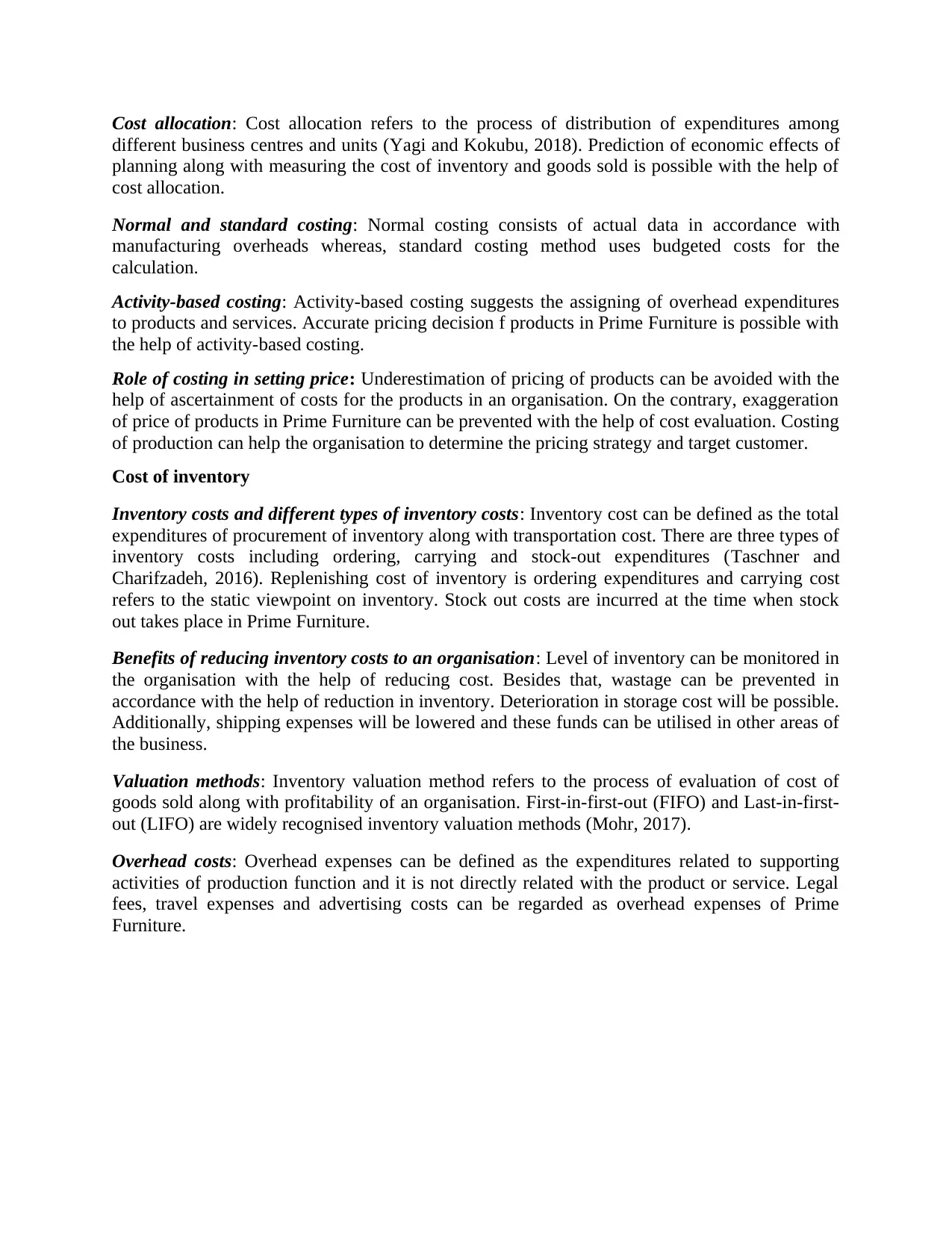
Cost allocation: Cost allocation refers to the process of distribution of expenditures among
different business centres and units (Yagi and Kokubu, 2018). Prediction of economic effects of
planning along with measuring the cost of inventory and goods sold is possible with the help of
cost allocation.
Normal and standard costing: Normal costing consists of actual data in accordance with
manufacturing overheads whereas, standard costing method uses budgeted costs for the
calculation.
Activity-based costing: Activity-based costing suggests the assigning of overhead expenditures
to products and services. Accurate pricing decision f products in Prime Furniture is possible with
the help of activity-based costing.
Role of costing in setting price: Underestimation of pricing of products can be avoided with the
help of ascertainment of costs for the products in an organisation. On the contrary, exaggeration
of price of products in Prime Furniture can be prevented with the help of cost evaluation. Costing
of production can help the organisation to determine the pricing strategy and target customer.
Cost of inventory
Inventory costs and different types of inventory costs: Inventory cost can be defined as the total
expenditures of procurement of inventory along with transportation cost. There are three types of
inventory costs including ordering, carrying and stock-out expenditures (Taschner and
Charifzadeh, 2016). Replenishing cost of inventory is ordering expenditures and carrying cost
refers to the static viewpoint on inventory. Stock out costs are incurred at the time when stock
out takes place in Prime Furniture.
Benefits of reducing inventory costs to an organisation: Level of inventory can be monitored in
the organisation with the help of reducing cost. Besides that, wastage can be prevented in
accordance with the help of reduction in inventory. Deterioration in storage cost will be possible.
Additionally, shipping expenses will be lowered and these funds can be utilised in other areas of
the business.
Valuation methods: Inventory valuation method refers to the process of evaluation of cost of
goods sold along with profitability of an organisation. First-in-first-out (FIFO) and Last-in-first-
out (LIFO) are widely recognised inventory valuation methods (Mohr, 2017).
Overhead costs: Overhead expenses can be defined as the expenditures related to supporting
activities of production function and it is not directly related with the product or service. Legal
fees, travel expenses and advertising costs can be regarded as overhead expenses of Prime
Furniture.
different business centres and units (Yagi and Kokubu, 2018). Prediction of economic effects of
planning along with measuring the cost of inventory and goods sold is possible with the help of
cost allocation.
Normal and standard costing: Normal costing consists of actual data in accordance with
manufacturing overheads whereas, standard costing method uses budgeted costs for the
calculation.
Activity-based costing: Activity-based costing suggests the assigning of overhead expenditures
to products and services. Accurate pricing decision f products in Prime Furniture is possible with
the help of activity-based costing.
Role of costing in setting price: Underestimation of pricing of products can be avoided with the
help of ascertainment of costs for the products in an organisation. On the contrary, exaggeration
of price of products in Prime Furniture can be prevented with the help of cost evaluation. Costing
of production can help the organisation to determine the pricing strategy and target customer.
Cost of inventory
Inventory costs and different types of inventory costs: Inventory cost can be defined as the total
expenditures of procurement of inventory along with transportation cost. There are three types of
inventory costs including ordering, carrying and stock-out expenditures (Taschner and
Charifzadeh, 2016). Replenishing cost of inventory is ordering expenditures and carrying cost
refers to the static viewpoint on inventory. Stock out costs are incurred at the time when stock
out takes place in Prime Furniture.
Benefits of reducing inventory costs to an organisation: Level of inventory can be monitored in
the organisation with the help of reducing cost. Besides that, wastage can be prevented in
accordance with the help of reduction in inventory. Deterioration in storage cost will be possible.
Additionally, shipping expenses will be lowered and these funds can be utilised in other areas of
the business.
Valuation methods: Inventory valuation method refers to the process of evaluation of cost of
goods sold along with profitability of an organisation. First-in-first-out (FIFO) and Last-in-first-
out (LIFO) are widely recognised inventory valuation methods (Mohr, 2017).
Overhead costs: Overhead expenses can be defined as the expenditures related to supporting
activities of production function and it is not directly related with the product or service. Legal
fees, travel expenses and advertising costs can be regarded as overhead expenses of Prime
Furniture.
Paraphrase This Document
Need a fresh take? Get an instant paraphrase of this document with our AI Paraphraser
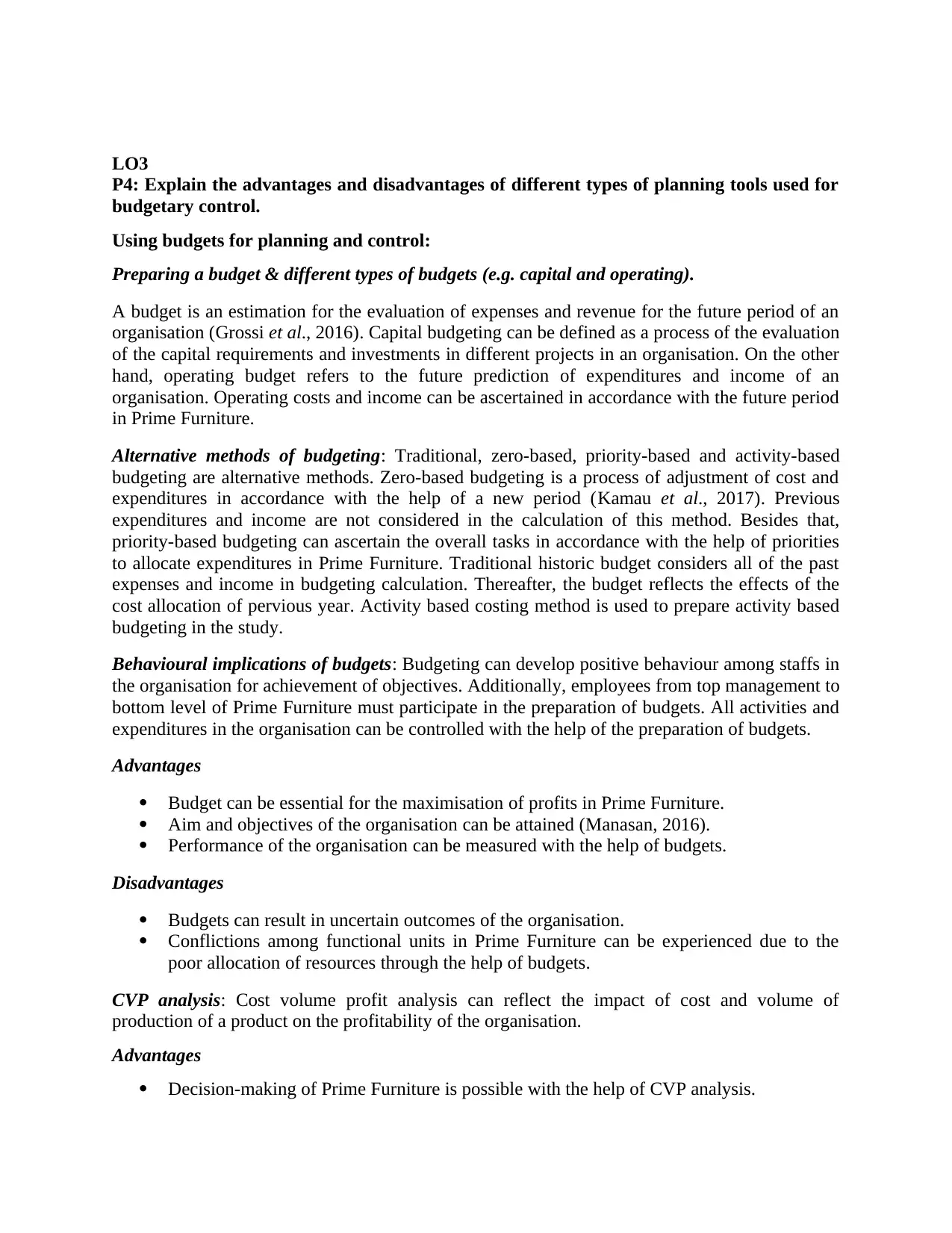
LO3
P4: Explain the advantages and disadvantages of different types of planning tools used for
budgetary control.
Using budgets for planning and control:
Preparing a budget & different types of budgets (e.g. capital and operating).
A budget is an estimation for the evaluation of expenses and revenue for the future period of an
organisation (Grossi et al., 2016). Capital budgeting can be defined as a process of the evaluation
of the capital requirements and investments in different projects in an organisation. On the other
hand, operating budget refers to the future prediction of expenditures and income of an
organisation. Operating costs and income can be ascertained in accordance with the future period
in Prime Furniture.
Alternative methods of budgeting: Traditional, zero-based, priority-based and activity-based
budgeting are alternative methods. Zero-based budgeting is a process of adjustment of cost and
expenditures in accordance with the help of a new period (Kamau et al., 2017). Previous
expenditures and income are not considered in the calculation of this method. Besides that,
priority-based budgeting can ascertain the overall tasks in accordance with the help of priorities
to allocate expenditures in Prime Furniture. Traditional historic budget considers all of the past
expenses and income in budgeting calculation. Thereafter, the budget reflects the effects of the
cost allocation of pervious year. Activity based costing method is used to prepare activity based
budgeting in the study.
Behavioural implications of budgets: Budgeting can develop positive behaviour among staffs in
the organisation for achievement of objectives. Additionally, employees from top management to
bottom level of Prime Furniture must participate in the preparation of budgets. All activities and
expenditures in the organisation can be controlled with the help of the preparation of budgets.
Advantages
Budget can be essential for the maximisation of profits in Prime Furniture.
Aim and objectives of the organisation can be attained (Manasan, 2016).
Performance of the organisation can be measured with the help of budgets.
Disadvantages
Budgets can result in uncertain outcomes of the organisation.
Conflictions among functional units in Prime Furniture can be experienced due to the
poor allocation of resources through the help of budgets.
CVP analysis: Cost volume profit analysis can reflect the impact of cost and volume of
production of a product on the profitability of the organisation.
Advantages
Decision-making of Prime Furniture is possible with the help of CVP analysis.
P4: Explain the advantages and disadvantages of different types of planning tools used for
budgetary control.
Using budgets for planning and control:
Preparing a budget & different types of budgets (e.g. capital and operating).
A budget is an estimation for the evaluation of expenses and revenue for the future period of an
organisation (Grossi et al., 2016). Capital budgeting can be defined as a process of the evaluation
of the capital requirements and investments in different projects in an organisation. On the other
hand, operating budget refers to the future prediction of expenditures and income of an
organisation. Operating costs and income can be ascertained in accordance with the future period
in Prime Furniture.
Alternative methods of budgeting: Traditional, zero-based, priority-based and activity-based
budgeting are alternative methods. Zero-based budgeting is a process of adjustment of cost and
expenditures in accordance with the help of a new period (Kamau et al., 2017). Previous
expenditures and income are not considered in the calculation of this method. Besides that,
priority-based budgeting can ascertain the overall tasks in accordance with the help of priorities
to allocate expenditures in Prime Furniture. Traditional historic budget considers all of the past
expenses and income in budgeting calculation. Thereafter, the budget reflects the effects of the
cost allocation of pervious year. Activity based costing method is used to prepare activity based
budgeting in the study.
Behavioural implications of budgets: Budgeting can develop positive behaviour among staffs in
the organisation for achievement of objectives. Additionally, employees from top management to
bottom level of Prime Furniture must participate in the preparation of budgets. All activities and
expenditures in the organisation can be controlled with the help of the preparation of budgets.
Advantages
Budget can be essential for the maximisation of profits in Prime Furniture.
Aim and objectives of the organisation can be attained (Manasan, 2016).
Performance of the organisation can be measured with the help of budgets.
Disadvantages
Budgets can result in uncertain outcomes of the organisation.
Conflictions among functional units in Prime Furniture can be experienced due to the
poor allocation of resources through the help of budgets.
CVP analysis: Cost volume profit analysis can reflect the impact of cost and volume of
production of a product on the profitability of the organisation.
Advantages
Decision-making of Prime Furniture is possible with the help of CVP analysis.
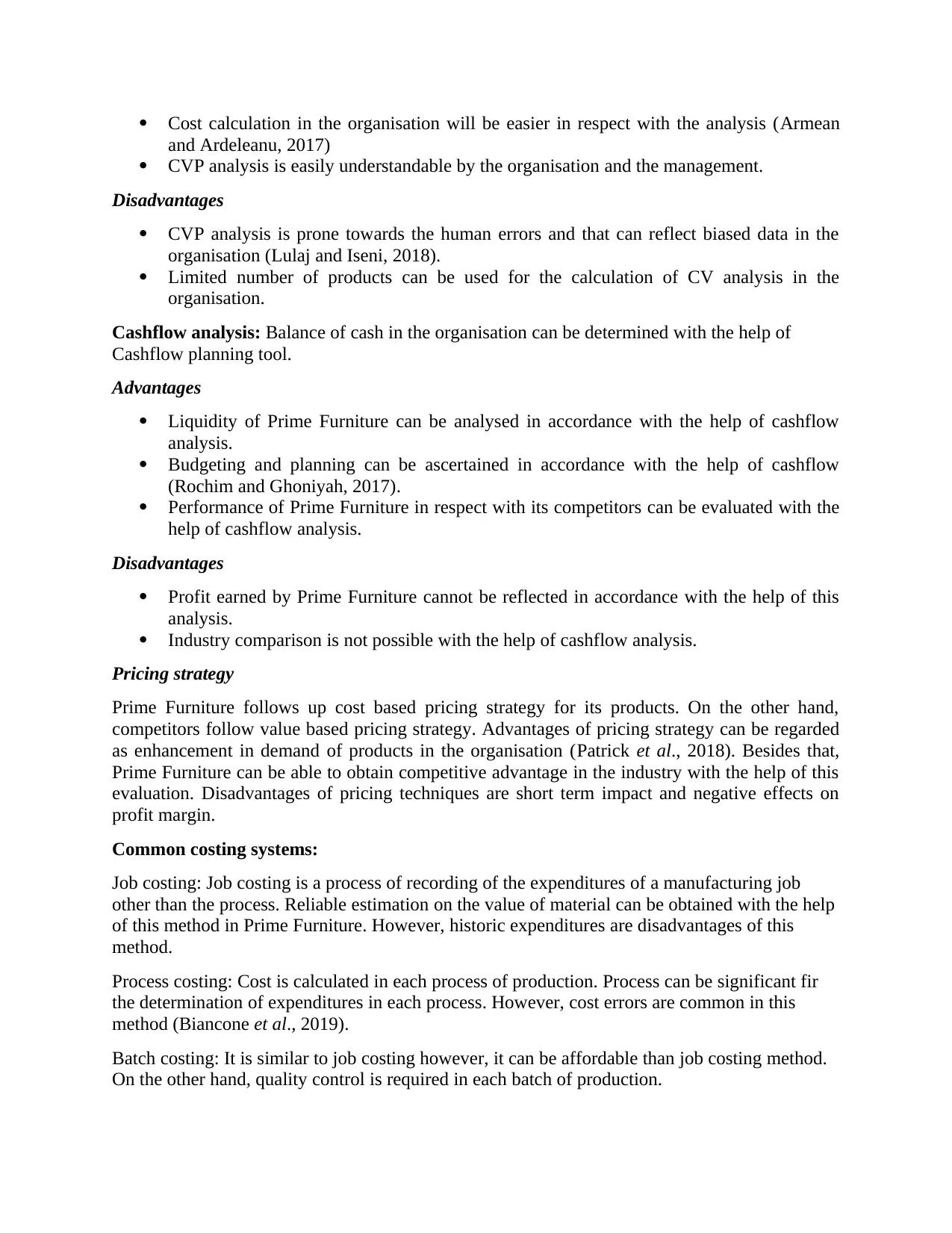
Cost calculation in the organisation will be easier in respect with the analysis (Armean
and Ardeleanu, 2017)
CVP analysis is easily understandable by the organisation and the management.
Disadvantages
CVP analysis is prone towards the human errors and that can reflect biased data in the
organisation (Lulaj and Iseni, 2018).
Limited number of products can be used for the calculation of CV analysis in the
organisation.
Cashflow analysis: Balance of cash in the organisation can be determined with the help of
Cashflow planning tool.
Advantages
Liquidity of Prime Furniture can be analysed in accordance with the help of cashflow
analysis.
Budgeting and planning can be ascertained in accordance with the help of cashflow
(Rochim and Ghoniyah, 2017).
Performance of Prime Furniture in respect with its competitors can be evaluated with the
help of cashflow analysis.
Disadvantages
Profit earned by Prime Furniture cannot be reflected in accordance with the help of this
analysis.
Industry comparison is not possible with the help of cashflow analysis.
Pricing strategy
Prime Furniture follows up cost based pricing strategy for its products. On the other hand,
competitors follow value based pricing strategy. Advantages of pricing strategy can be regarded
as enhancement in demand of products in the organisation (Patrick et al., 2018). Besides that,
Prime Furniture can be able to obtain competitive advantage in the industry with the help of this
evaluation. Disadvantages of pricing techniques are short term impact and negative effects on
profit margin.
Common costing systems:
Job costing: Job costing is a process of recording of the expenditures of a manufacturing job
other than the process. Reliable estimation on the value of material can be obtained with the help
of this method in Prime Furniture. However, historic expenditures are disadvantages of this
method.
Process costing: Cost is calculated in each process of production. Process can be significant fir
the determination of expenditures in each process. However, cost errors are common in this
method (Biancone et al., 2019).
Batch costing: It is similar to job costing however, it can be affordable than job costing method.
On the other hand, quality control is required in each batch of production.
and Ardeleanu, 2017)
CVP analysis is easily understandable by the organisation and the management.
Disadvantages
CVP analysis is prone towards the human errors and that can reflect biased data in the
organisation (Lulaj and Iseni, 2018).
Limited number of products can be used for the calculation of CV analysis in the
organisation.
Cashflow analysis: Balance of cash in the organisation can be determined with the help of
Cashflow planning tool.
Advantages
Liquidity of Prime Furniture can be analysed in accordance with the help of cashflow
analysis.
Budgeting and planning can be ascertained in accordance with the help of cashflow
(Rochim and Ghoniyah, 2017).
Performance of Prime Furniture in respect with its competitors can be evaluated with the
help of cashflow analysis.
Disadvantages
Profit earned by Prime Furniture cannot be reflected in accordance with the help of this
analysis.
Industry comparison is not possible with the help of cashflow analysis.
Pricing strategy
Prime Furniture follows up cost based pricing strategy for its products. On the other hand,
competitors follow value based pricing strategy. Advantages of pricing strategy can be regarded
as enhancement in demand of products in the organisation (Patrick et al., 2018). Besides that,
Prime Furniture can be able to obtain competitive advantage in the industry with the help of this
evaluation. Disadvantages of pricing techniques are short term impact and negative effects on
profit margin.
Common costing systems:
Job costing: Job costing is a process of recording of the expenditures of a manufacturing job
other than the process. Reliable estimation on the value of material can be obtained with the help
of this method in Prime Furniture. However, historic expenditures are disadvantages of this
method.
Process costing: Cost is calculated in each process of production. Process can be significant fir
the determination of expenditures in each process. However, cost errors are common in this
method (Biancone et al., 2019).
Batch costing: It is similar to job costing however, it can be affordable than job costing method.
On the other hand, quality control is required in each batch of production.
⊘ This is a preview!⊘
Do you want full access?
Subscribe today to unlock all pages.

Trusted by 1+ million students worldwide
1 out of 24
Related Documents
Your All-in-One AI-Powered Toolkit for Academic Success.
+13062052269
info@desklib.com
Available 24*7 on WhatsApp / Email
![[object Object]](/_next/static/media/star-bottom.7253800d.svg)
Unlock your academic potential
Copyright © 2020–2025 A2Z Services. All Rights Reserved. Developed and managed by ZUCOL.





